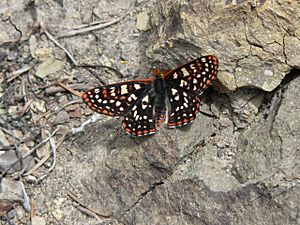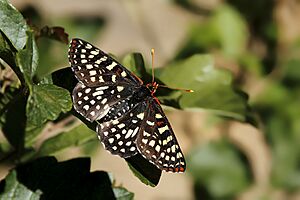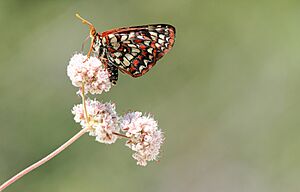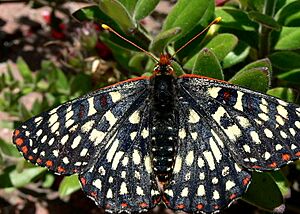Variable checkerspot facts for kids
Quick facts for kids Variable checkerspot |
|
|---|---|
 |
|
| In the William O. Douglas Wilderness | |
| Scientific classification | |
| Kingdom: | |
| Phylum: | |
| Class: | |
| Order: | |
| Family: | |
| Genus: |
Euphydryas
|
| Species: |
E. chalcedona
|
| Binomial name | |
| Euphydryas chalcedona (Doubleday, 1847)
|
|
The variable checkerspot or Chalcedon checkerspot (Euphydryas chalcedona) is a type of butterfly found in western North America. Its home stretches from Alaska in the north all the way down to Baja California in the south. It also spreads east through the Rocky Mountains into states like Colorado, Montana, New Mexico, and Wyoming.
This butterfly usually has a brown or black body with lots of white and yellow checkerboard patterns. It also has some red on its top wings. When it's an adult, its wings can spread from about 3.2 to 5.7 centimeters (1.3 to 2.2 inches) wide. Adult butterflies drink nectar from flowers. Young variable checkerspot butterflies, called larvae (or caterpillars), eat different plants. These include snowberry, paintbrush, Buddleja, Diplacus aurantiacus, and Scrophularia californica.
Female butterflies that are ready to lay eggs look for plants like Diplacus aurantiacus. They choose plants that are close to nectar sources. The larvae that hatch from these eggs live and eat on these "host plants." Some of these plants have ways to stop the larvae from eating their leaves. After a while, the larvae move to a darker, hidden spot and go into a resting state called diapause. They wake up between January and March. Then, they turn into a pupa (or chrysalis) usually starting in April.
The variable checkerspot butterfly is food for many birds. But these butterflies have a special trick! Their diet as larvae includes certain compounds called iridoids. These compounds make the butterfly taste bad to birds. Also, their bright red color helps warn predators to stay away.
Contents
About the Variable Checkerspot
The variable checkerspot is part of the group called Lepidoptera. This group includes all butterflies and moths. It belongs to the family Nymphalidae, which also has butterflies like the tortoiseshells and admirals. The variable checkerspot is in the genus Euphydryas. This genus includes other checkerspot butterflies, such as Euphydryas editha and Euphydryas phaeton. There are ten different types, or subspecies, of Euphydryas chalcedona.
Appearance
The variable checkerspot butterfly is usually brown-black. It has many yellow, red, and white spots on its top wings. The underside of its wings often has yellow and orange stripes. As its name suggests, this butterfly can look very different from one place to another. For example, butterflies in the Sierra Nevada mountains might have a brick-red background with brown and yellow marks. Those in northern California might be yellow and black. Adult butterflies have a wingspan of about 3.2 to 5.7 centimeters (1.3 to 2.2 inches).
Where They Live
The variable checkerspot lives all over western North America. You can find them from Alaska in the north down to Baja California and Mexico in the south. To the west, their home is bordered by the Pacific Ocean. To the east, they live past the Rocky Mountains in states like Montana, Wyoming, Colorado, and New Mexico.
These butterflies live in many different places. This includes dry sagebrush areas, desert hills, grassy prairies, open forests, and cold mountain tundras.
Life Cycle
The variable checkerspot lays its eggs in groups. Before they go into their resting state (diapause), young larvae often move to fresh parts of the plant. This helps them find better food. Before they start their long rest, the larvae leave the food plant. They look for good places to hide, like under the bark of dead branches, inside hollow dried plant stems, or in cracks in rocks.
During this resting period, some larvae can wake up and eat a little. Then they go back to sleep. The larvae usually come out of their resting state between late January and mid-March. However, in very high mountain areas, larvae might stay in this resting state for several years! They start turning into a pupa (chrysalis) in early to mid-April. Adult butterflies then start flying between mid-April and May, and they keep flying into June. An adult variable checkerspot butterfly usually lives for about 15 days.
Reproduction
Finding a Mate
Male variable checkerspot butterflies look for females mainly based on where the females are. For these butterflies, females often gather in large numbers near the plants where the larvae eat. The most wanted females for males are those that have not mated yet. These virgin females are most often found near the larval host plants. So, male butterflies have learned to look for mates near these plants. Males will either sit near the food plants or fly around them to find females ready to mate. Male butterflies do not stay in one spot for long. They also do not try to protect their mating areas. Males use their eyesight to find females, not smells.
Egg Laying
Female butterflies need to lay their eggs quickly because their breeding time is short. In some other butterfly species, males might bother females a lot. This can make mated females go to areas where there are fewer males. This is because too much bothering can stop females from finding food and laying eggs.
However, this is not the case for the variable checkerspot. Female variable checkerspots always lay their eggs near good larval food sources. They do this no matter how many males are around.
Group Behavior
During the time when adults are flying, you can find large groups of variable checkerspot butterflies across western North America. Each butterfly can find good areas with lots of larval food plants. They usually do not stay in other parts of the landscape. This means you often find small groups of these butterflies that are separate from other groups. Females do not fly as much as males. Males often fly around their homes and sit in open areas while looking for female mates.
When the variable checkerspot flies depends on the region. In California and Oregon, they usually fly from April to June. Further north and in higher places, they typically fly from June to July.
Diet
The variable checkerspot's diet changes a lot as it grows. As a larva (caterpillar), it is a herbivore, meaning it eats only plants. As an adult butterfly, it eats only nectar.
Larval Diet
The main food for variable checkerspot larvae is the leaves of a plant called Diplacus aurantiacus. This plant is also usually where the female butterfly lays her eggs. D. aurantiacus has a lot of a sticky substance in its leaves. This helps the plant not lose water when it's dry. Studies show that if a plant has more of this sticky substance, the larvae do not grow as well and are less likely to survive. This means the sticky substance helps stop larvae from eating the leaves.
Another thing in D. aurantiacus plants that affects larval growth is how much nitrogen is in the leaves. Unlike the sticky substance, more nitrogen means the larvae grow better and survive more often. In one test, larvae that ate fertilized D. aurantiacus plants (which had 50% more nitrogen) survived and grew better than those eating unfertilized plants. Larvae like leaves with more nitrogen. However, these leaves are also very important for the plant to make energy. So, the larvae and the D. aurantiacus plants have a special timing. Larvae come out of their resting state (diapause) when D. aurantiacus plants start to flower. This is when the plants need the most energy. The plants then put their sticky substance into their newest leaves, which have the most nitrogen. This sticky substance stops the larvae from eating these important new leaves. So, the larvae are forced to eat older leaves that have less nitrogen. To get the best food, larvae choose leaves with the highest amount of nitrogen compared to the sticky substance. Also, larvae strongly prefer to eat leaves that have been in the sun over those in the shade.
Another plant that variable checkerspot larvae sometimes eat is Scrophularia californica. This plant does not have the sticky defense system that D. aurantiacus has. So, it is easier for larvae to digest. Larvae that eat S. californica grow faster and bigger than those that eat D. aurantiacus. Even though D. aurantiacus might not be the best food, it is the most common and reliable host plant for the variable checkerspot. It is also often the plant closest to nectar sources. This is why it is the main host plant and food source for the larvae.
Adult Diet
Unlike the larvae, adult variable checkerspot butterflies mainly eat nectar. They get this nectar from flowers. In a place called Jasper Ridge Biological Preserve in California, the adult butterflies most often drink nectar from a plant called Eriodictyon californicum.
Diet and Egg Laying
What the adult butterfly eats greatly affects why it chooses D. aurantiacus to lay its eggs. Adult butterflies like to lay eggs on host plants that are close to nectar sources. At the Jasper Ridge site, D. aurantiacus is the host plant closest to the E. californicum nectar source. Being close to nectar is more important than the plant's food quality compared to other host plants. This is why D. aurantiacus is the main host plant for variable checkerspot butterflies.
Defense Against Predators
The main predators of the variable checkerspot are birds. It is rare to see birds eating butterflies directly because butterfly groups are usually spread out.
One study looked at many detached variable checkerspot wings found where butterflies lived. These wings had marks from bird beaks and special triangle-shaped tears. This showed that birds attacked the butterflies and pulled off their wings before eating the body. Also, photos of variable checkerspot butterflies sometimes show individuals with beak marks and tears. This means birds tried to eat them but did not succeed.
Studies have found that birds attack female butterflies more often. This is because birds tend to attack butterflies with less bright red color. Male butterflies have more variety in their color and can be more intensely red. This means, on average, females face more attacks than males. Red is a warning color for many butterflies. So, it is possible that less bird attacks are linked to this warning signal. The pressure from birds hunting by sight might have played a big part in how the variable checkerspot's wing color and pattern developed.
Defense Strategy
The variable checkerspot, like many other butterflies, has a defense strategy. It tastes bad to birds. This helps it avoid being eaten. In a test, birds that tried to eat a variable checkerspot often shook their heads and wiped their beaks. This is a sign that they tasted something unpleasant. The bad taste of the butterfly is likely because of certain compounds called iridoid glycosides. These compounds come from the plants the larvae eat, which are mostly from the scrophulariaceous family.
Iridoid Glycosides
The main iridoid glycoside found in the diet of variable checkerspot butterflies is called catalpol. Tests show that catalpol is the only iridoid glycoside in adult butterflies. These compounds are very important for larvae to develop their bad taste to birds. Iridoids also make larvae want to eat more. If given a choice between food with no additives and food with iridoid glycoside compounds, larvae prefer the food with the extra iridoid compounds. They use their sense of smell to find them. The main host plants of the variable checkerspot are all rich in catalpol compounds. The presence of these compounds plays a key role in which host plant females choose when they lay their eggs. This suggests that the variable checkerspot has evolved to use iridoid compounds to encourage females to lay eggs and to encourage larvae to eat.
See also
 In Spanish: Euphydryas chalcedona para niños
In Spanish: Euphydryas chalcedona para niños




